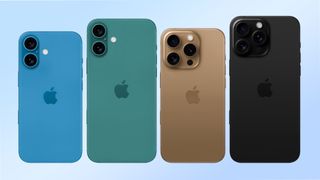iPhone 16 A18 chip — 5 things you need to know about Apple’s new silicon
Meet the chipset that's going to power the new iPhones

A new iPhone means a new system-on-chip to power Apple's latest handsets. With this year's iPhone 16 launch that's expected to be the A18. And ahead of next week's Apple event, it feels as if there's a lot more focus than usual on the silicon Apple plans on using in the next iPhone models
A couple of factors explain why the A18 find itself the subject of attention. For starters, Apple is rolling out a series of AI-focused features in the form of Apple Intelligence, and the A18 will play a large roll in how those capabilities perform. And there's the usual interest in what the new chipset will mean in terms of performance and power efficiency, as is the case with any new phone launch.
But there's another reason for why more attention than usual is being directed toward the A18 and what it brings to the iPhone 16 lineup. For years, all you really needed to know about the Apple-designed chips that powered the latest iPhones is that they were unquestionably the best mobile performers out there, routinely beating the silicon inside Android phones in a number of benchmarks. But lately, Qualcomm's top chips have pulled even with Apple's best efforts, with the current Snapdragon 8 Gen 3 inside the Galaxy S24 Ultra even out-muscling recent Apple offerings like the A17 Pro and A16 Bionic in some areas.
Understandably, the pressure's on Apple to regain its undisputed performance crown. So people are eager to see if the A18-powered iPhone 16 models will be able to do just that. Here's what we know so far about the A18 silicon based on various rumors surrounding Apple's upcoming chipsets, with full details set to emerge during the iPhone 16 launch on September 9.
Which new iPhones will get the A18 chipset?

Up until a few years ago, Apple equipped every iPhone it released in a given year with the same chipset — or at least, a variant of the same chipset in the case of some Pro models. But starting with the iPhone 14 series, Apple began to mix things up. The Pro phones featured the latest Apple silicon, while the standard and Plus models came equipped with the previous year's system-on-chip.
In the case of the iPhone 15, that's meant that the same A16 Bionic chip found in the iPhone 14 Pro now runs the show for the iPhone 15. Meanwhile, the iPhone 15 Pro and iPhone 15 Pro Max sport the newer A17 Pro silicon.
That split-silicon approach is apparently coming to an end with the iPhone 16 releases, as the consensus seems to be that Apple will use an A18 chip in each of its new models. That's backed up by leaked code that indicates a similar chip across the iPhone 16, iPhone 16 Plus, iPhone 16 Pro and iPhone 16 Pro Max.
Sign up to get the BEST of Tom's Guide direct to your inbox.
Get instant access to breaking news, the hottest reviews, great deals and helpful tips.
Will the iPhone 16 and iPhone 16 Pro feature the same version of the A18?

The chips inside the iPhone 16 models may have the same branding, but that doesn't necessarily mean they'll have the same overall design. It's expected that the base model iPhone 16 will have one version of the A18, while the iPhone 16 Pro and iPhone 16 Pro Max will feature a Pro version of the chipset. Rumors differentiate these chips by calling them the A18 and A18 Pro, though it's possible Apple would go with different names once it announces the new phones.
Leaked specs posted on Weibo claim the A18 chip will have a six-core CPU; two of those will allegedly be performance cores, while the remaining ones will be efficiency cores. In terms of graphics, the leak says the A18 would have a five-core GPU.
iPhone 16: What about A18 performance?

One other thing about the CPU in the A18 Pro chipset — it's supposed to top 4GHz, which would be an improvement on the A17 Pro's 3.8GHz speed. That should lead to an overall improvement in performance, though it's hard to quantify just how big a gain based on leaked A18 benchmarks, which have been all over the map.
Benchmarks circulated at the start of the year listed the iPhone 16 Pro posting Geekbench numbers that would not only top current phones but also the M3 Max-powered MacBook Pro. A less fanciful leak has shown single-core and multicore scores of 2,822 and 8,571, respectively, which would fall behind leaked numbers for the Snapdragon 8 Gen 4 supposedly set to power next year's Galaxy S25 flagships.
While leaked Geekbench results are fun to toss around, they're not the most reliable indicator of performance, as the final version of a chipset could be configured quite differently from the ones being tested in unreleased devices. Nevertheless, it's safe to anticipate solid performance gains over the A17 Pro.
What about AI features for the A18?

The chips powering phones these days need to supply more than just blazing speed — they also need to be smarter. And the A18 figures to be a big part of Apple's push into AI features for its phones.
To that end, one rumor claims the A18's neural engine can outperform the one in M4 chipset found in the iPad Pro. We're not sure how much faith to put into that claim, but it certainly stands to reason that Apple will want a chip with a high-performing neural engine to help run Apple Intelligence features on device.
In a related rumor, the iPhone 16 models are expected to feature lots of RAM to help shoulder the AI load. For example, the iPhone 16 will reportedly ship with 8GB of RAM, a boost from the 6GB found in the current iPhone 15 model.
What comes after the A18?
The A18 is expected to be built on a 3-nanometer process, the same as the A17 Pro. But it's the 2025 iPhones that could see a switch to a 2nm chipset, which would be good for performance. Chips with smaller nanometer specs pack transistors more densely together, which tends to usher in some serious performance and power efficiency gains. Alas, you'll have to hold off for the iPhone 17 in order to reap those benefits.
More from Tom's Guide
Philip Michaels is a Managing Editor at Tom's Guide. He's been covering personal technology since 1999 and was in the building when Steve Jobs showed off the iPhone for the first time. He's been evaluating smartphones since that first iPhone debuted in 2007, and he's been following phone carriers and smartphone plans since 2015. He has strong opinions about Apple, the Oakland Athletics, old movies and proper butchery techniques. Follow him at @PhilipMichaels.
